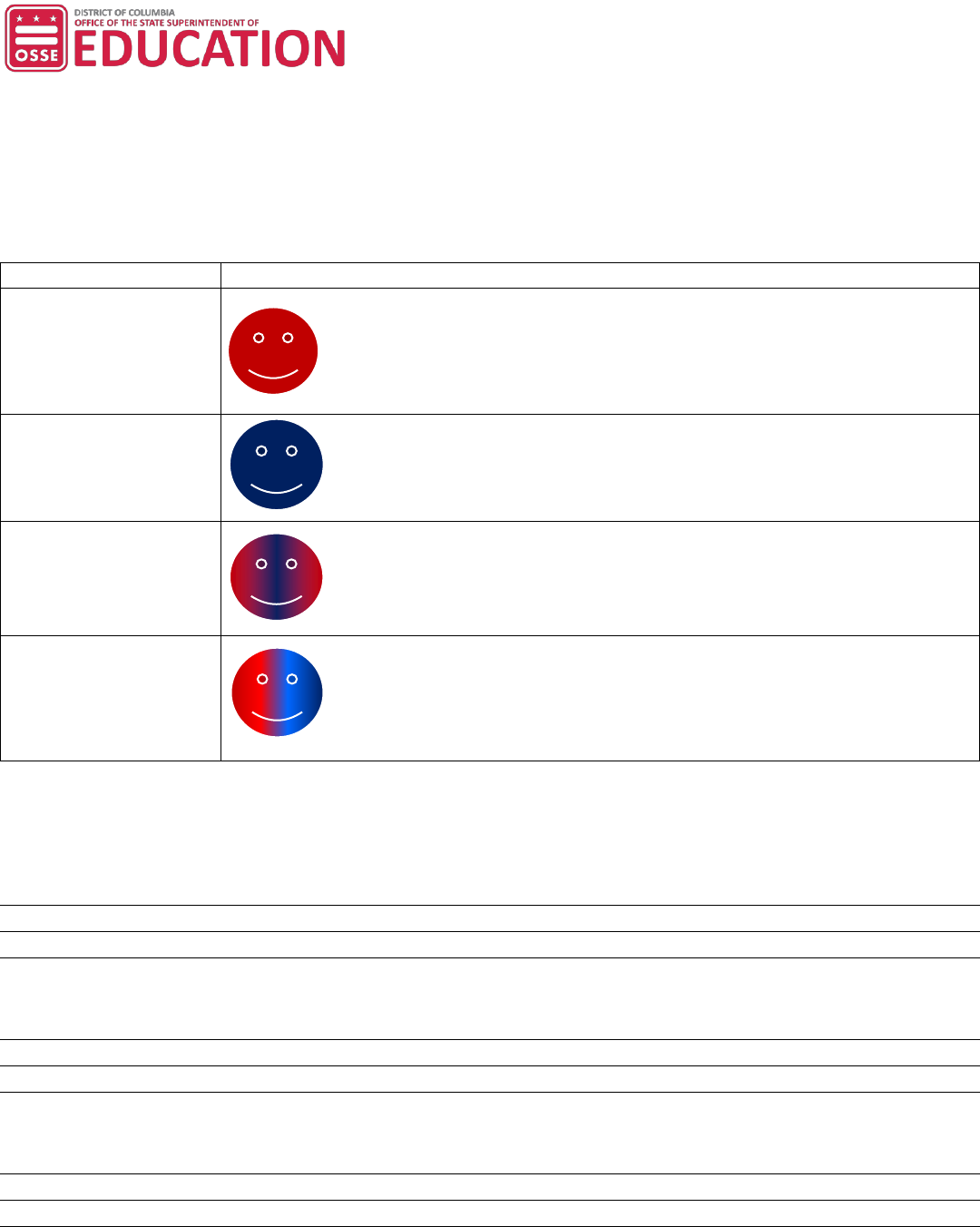
Division of Teaching and Learning
2
Warm-up Activity Slide 3
Student A
What can the student do?
What supports does the student need?
How would you engage the student in meaningful
instructional tasks?
What instructional resources will you need?
How will you measure successes?
Student B
What can the student do?
What supports does the student need?
How would you engage the student in meaningful
instructional tasks?
What instructional resources will you need?
How will you measure successes?

Division of Teaching and Learning
3
Three Linguistic Spaces – In Bilingual Students Slides 7-9
Instructions: Based on the emergent bilingual profiles, write down the number of emergent bilinguals enrolled in your
school/classroom and respond to the questions below.
Individual task
Number of Students
Emergent Bilingual
• Students who enter the program as monolingual speakers (Spanish,
French, Chinese, etc.).
• These students are classified as English learners.
• In a dual-language program, these students will become sequential
bilinguals.
• Students who enter the program as monolingual English speakers (non-
English learners).
• In a dual-language program, these students will become sequential
bilinguals.
• Students who enter the program with linguistic resources in both
languages.
• These students may or may not qualify as English learners.
• These students enter the school system as simultaneous bilinguals.
• Other English learners (Mixteco speakers, for example) and other bilingual,
non-English learners (French/English bilinguals, for example) who have a
background in a third language (not one of the program languages).
• In a Spanish/English dual-language program, these students will become
trilingual.
Team task
How can this information help you meet the needs of your students?
What kind of instructional differentiation (in addition to instruction in Spanish) is needed?
How can you explain and defend this need to parents and school administrators?

Division of Teaching and Learning
4
Three Linguistic Spaces – In Curriculum and Schedules Slides 10-17
Instruction: After defining and understanding the language allocation plan implemented at your school, work with your
team and think about your current practices and the content area in which you are delivering instruction. Fill out the
form below indicating the concepts that are transferable from L1 to L2 and topics and/or concepts that need explicit
instruction in the target language.
Concept by Subject
Transfer from one language to another
Non-transferable, needs explicit instruction
in the target language.
Math
Science
Social Studies
Language Arts
Bilinguals transfer
The cross-language connection occurs
because

Division of Teaching and Learning
5
Planning to Develop Cross-language Connections Slides 19-25
Areas of Focus for Contrastive Analysis
Element and Area of Focus
Examples
Phonology (sound system)
• Sounds that are different in two languages
• Sounds that are similar in the two languages
• Sound-symbol correspondence (e.g., the [k] sound:
“qu” or “c” in Spanish; “c” or “k” in English)
• Silent letters (e.g., “h” and “u” in Spanish; many in
English)
• The existence of the [th] sound in English but not in
Spanish; therefore, students select the closest
Spanish phoneme, which is /d/
Morphology (word formation)
• Prefixes and suffixes shared between the two
languages (cognates)
• informal – informal
• informar – inform
• socialismo – socialism
• desastroso – disastrous
• preparer – prepare
• profesión – profession
• educación – education
Syntax and grammar (sentence structure)
• Rules for punctuation, grammar, word order, and so
forth, unique to each language
• Areas that are similar and areas that are different
• Spanish uses the initial inverted exclamation point;
English does not (e.g., ¡Me encanta! – I love it!)
• Articles have gender in Spanish but not in English
(e.g., el título – the title; la revolución – the
revolution)
• In Spanish, accents change the meaning of words
(e.g., el papa vive en Roma; la papa es deliciosa; mi
papá es muy trabajador)
• Spanish has many reflexive verbs; English has few
(e.g., Se me cayó)
• Conjugation of verbs in Spanish reduces the need
for the pronoun (e.g., ¡Voy!)
• An adjective follows a noun in Spanish and
precedes it in English (e.g., centímetros cuadrados –
square centimeters)
• English contains possessive nouns; Spanish does
not (e.g., my grandmother’s house – la casa de mi
abuela)
Pragmatics (language use)
• Cultural norms or comments that are reflected in
language use
• Use of overlapping cultural norms in a bilingual
context
• Questions about age avoid the word “old” in
Spanish because it has a negative connotations
(¿Cuántos años tienes?)
• Figurative language from English is translated
directly into Spanish: Estoy encerrado afuera (I am
locked out!) rather than Me quedé afuera.
• Spanish constructs are used during English (Mis
padres ganan mucho dinero – my fathers win lots of
money).

Division of Teaching and Learning
6
Planning to Develop Cross-language Connections Slides 19-24
Planning for Cross-Language Connections
1. Review in the language of instruction.
How are students using their linguistic resources when
they speak? When they write?
How do they use ALL their languages?
4. Match the keywords/phrases/sentences to the other
language.
Which foundational skills can be highlighted during the
contrastive analysis bridge? Which linguistic similarity or
difference is appropriate at my grade level?
2. Elicit keywords/phrases/sentences in the language of
instruction from students.
If these are the words that the students will transfer,
which linguistic similarity or difference should I highlight?
5. The bridge for metalinguistic analysis. Compare and
contrast languages.
Consider the four areas of metalinguistic focus:
phonology, morphology, syntax and grammar,
pragmatics.
3. The bridge for transfer: Practice the terms in the new
language.
Does the contrastive bridge include both languages? Is
the contrastive bridge color-coded?
6. Extension: Continued practice in the other language.
Is it clear to the students what they will be practicing?

Division of Teaching and Learning
7
Strategies to Develop Cross-language Connections Slides 25-36
Directions: Use the template below to take notes about each of the strategies practiced in the workshop. Check the
purpose of each strategy.
Strategy
Purpose
Observation Charts/Exploration Report
______ Transfer
______ Contrastive Analysis
Cognitive Content Dictionary
______ Transfer
______ Contrastive Analysis
Input Charts
______ Transfer
______ Contrastive Analysis
Así se dice – That’s how you say it
______ Transfer
______ Contrastive Analysis
Side by side
______ Transfer
______ Contrastive Analysis

Division of Teaching and Learning
8
The Three Instructional Moments Slides 37-44
Sample metalinguistic charts with additional areas of metalinguistic focus.
Note: In the classroom, these charts would be
• Created with the students
• Color-coded
• Accessible to students so that they could add further examples of the metalinguistic pattern
Verbos + Preposiciones
Verbs + Prepositions
Pensar en / pensar acerca de
To think about / to think of
Enojarse con
To get mad at
Soñar con
To dream of
Decidir sobre
To decide on
la, las, el, la
my, your, his, her, their, our
Hacer la tarea.
To do your homework.
Levantar la mano.
To raise my hand.
Different number of words in English than in Spanish
Español
English
Voy a buscar la tarea.
I am going to look for my homework.
Llamé a la maestra.
I called the teacher.
¡Me mojaron los zapatos!
They got my shoes wet!
tomar
hacer
to do
to make
to take
tomar una decisión
to make a decision
hacer la tarea
to do your homework
tomar turnos
to take turns

Division of Teaching and Learning
9
The Three Instructional Moments Slides 37-44
Grapho-phonemic Transfer from Spanish and English
Vowels
Vowels in Spanish have only one sound. Therefore, the concepts of long vowels, short vowels, r-controlled vowels, and
schwa vowels in English have no Spanish equivalent. Additionally, nearly every vowel in Spanish is pronounced, so two
vowels don’t “go walking” and that silent, but bossy, final “e” is conceptually foreign. However, “u” is mute when it
appears after “g” and “q” and before to vowels “e” and “i” as in queso, guitarra, quiero.
English Letter/Sound
Spanish Equivalent
Example
/Ā/ as in able
/Ē/ as in ear
/Ī/ as in icicle
/o/ as in octopus
/ū/ as in uniform
Consonants – Individuals and Clusters
e; ei
i
Ai; ay; hay; (the “h” is silent in Spanish)
a
iu
trein/train
sin/seen
Ay/I; bait/bite
cat/cought
ciut/cute
English Letter(s)/Sound
Spanish Equivalent
Example
Cc – ck
D – as in food or door
Soft g – as in gesture or giraffe
H – as in hair
J – as in Jello
Qu – as in quaint or quote
Sh – as in Sheep. This sound only
exists in Spanish words of native
origin, such as Uxmal.
Th – as in thumb
V – as in vest
W – as in Washington. This sound
does not exist in Spanish.
Y – as in yarn
Z – as in zipper
c, k, Qu
d or r
y; ll
j
y; ll
cua, cuo
X (though usually less familiat to
students here); next closest
approximation is ch.
d
f; b/v
gu ( as in agua)
ll
s
Soquer/soccer; tiket/ticket
Fur/food
lliant/giant
jelp/help
yumo/jump or llelo/yellow
cuin/queen
chain/shine
den/then
fine/vine
guent/went
llam/yam
sebra/zebra
* Spanish had no S-initiated blends (sc, scr, sk, sl, sm, sn, sp, spl, st, sw…)
* Spanish has few contractions (del, al) and they do not use an apostrophe.
* Spanish sentences have flexible word order structures (e.g., voy corriendo, corriendo voy).
* Spanish does not require the use of pronouns, as they are indicated in the verb conjugation (e.g., hablo = yo hablo/I
speak).
* Spanish rarely has double letter (happen/happen; buk/book).

Division of Teaching and Learning
10
The Three Instructional Moments Slides 37-44
Cross-language effects of Spanish derivational awareness on English vocabulary and reading comprehension were studied
in Spanish-speaking English language. English phonological awareness, and English word reading revealed that Spanish
derivational awareness was related to English cognate vocabulary. Knowledge of cognates facilitates the transfer of
Spanish derivational awareness to English vocabulary and reading comprehension.
Inflection - yields different grammatical forms of a word without altering its meaning or part of speech.
Example:
book – books play – played
libro – libros juego – jugué
Compounding - refers to the information of new words by combining two or more words.
Example:
airplane sunflower grasshopper
aeroplano girasol saltamontes
Derivation - forms a new word by combining a root word with an affix (prefix or suffix). The word carries the basic meaning
and the affix modifies or adds meaning to the root.
Example:
farmer baker carpenter cooker
granjero panadero carpintero cocinero
A reader who is aware of morphological relations can deduce the meaning of a novel word from its constituent
morphemes.

Division of Teaching and Learning
11
Closing Activity
Goal
What is the purpose of planning and implementing
cross-language connection strategies in a dual-
language/bilingual program?
Students
What is expected for students to demonstrate
during cross-language connection instruction?
Implementation
Which strategy(es) would you consider
implementing before the end of this school year?
Why?
How would these strategies facilitate collaboration
among teachers delivering instruction in two
languages?

